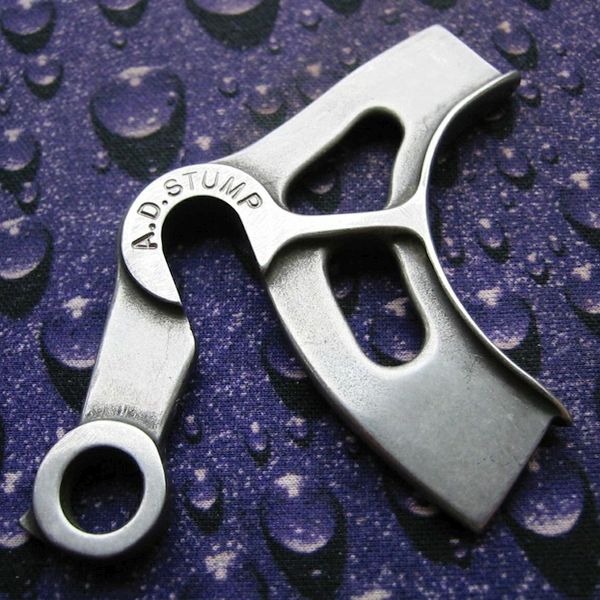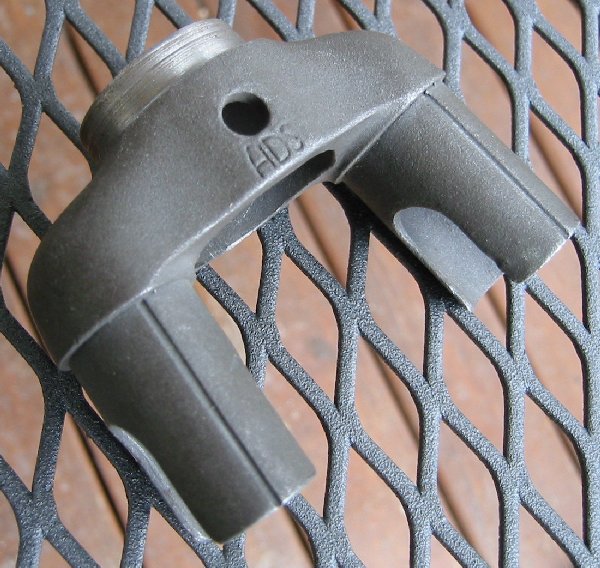

As one who specializes in collector's bicycles, I keep an eye out for signs of public interest in the kind of work I do. Thus, it was with great interest that I read some time back an article about the then- new Reynolds 753 tubing. The author said that since an even section frame joint is especially necessary with that tubing, we may see a revival of handcut lugs.
The need for uniform thickness at the frame joint is important because overheating of the thin section tubing can occur if the lugs are on the heavy side.
Thinning the lug and cutting it to make an attractive design has two technical benefits. First, it lightens the lug and allows brazing or silver soldering of the joint to be done at a lower temperature, with less danger of overheating the thin-walled tube. Second, the flow of the silver solder can be seen more easily with a design in the lug that gives a few "windows" to see into the joint.
I believe a lugged frame is stronger than a lugless frame. The lug offers a joint that in effect grabs another handful of tubing and spreads the stress on the frame over a greater area. The lugless frame, made with thin-walled tubes, can present a risk with the need for a heavy fillet radius to make a strong joint. And the low temperature solders I prefer do not build up a fillet or heavy radius at the joint.
Brass or bronze rod can be built up into a fillet joint, depending on the skill of the builder, but it takes quite a bit more heat. And it needs to be filed into a uniform-radius bend for pleasing appearance.
Brass or bronze is hard to file, and it takes a good sharp file to cut it. The problem of thinning the tube wall is ever present. The tendency to "guide" off the tube at the start of the fillet is difficult to avoid, as the sharp file will bite into the tube to get the appearance of a continuous joint. I don't condemn all lugless frames. With heavy-walled tubing, they are fine. The heavy wall gives a needed safety margin. I have seen lugless tandem frames that were noticeably undercut or thinned when the fillet had been filed, either by hand or with power-driven rotary-file or polishing tools.
I have always been partial to well-built bicycles with handcut lugs. I liken a well-designed lugged frame to a good engraved English shotgun. It doesn't shoot any better than a plain shotgun, but it is pretty and shows the builder's care in making it.
Because of high labor costs, few builders now make frames with handcut lugs. A decade ago, I asked Bill Harlow to build such a frame for me. Even back then, he said the cost of his time would make it impossible. How much time? He told me he could cut a set of lugs in a day. Bill must work very quickly or have extra long days.
My personal interest in handcut lugs goes back many years. On my first bicycling trip to England in 1937, I looked over the frames built by the classic builders of that time: Claude Butler, Bates, and Hetchins, to name a few. I also admired the Thanet on display in London's South Kensington Museum; that bike had been sectioned to show the joining of the Reynolds tubes.
On my next trip in 1964, I ordered a Gillott frame with fleur-de-lis lugs. Ron Cooper, who was learning his trade at the Gillott shop then, built my bike.
I decided to try building my own handcut lugged frame. In 1967, I came back from a third trip to England armed with a set of tubing and Nervex blank lugs.
That first frame took me a long time; during my spare time I built tooling and jigs to construct it. I adapted my lug design from the Gillott and Hetchins designs, and my initials in the bottom of the head lug.
The variety of patterns that can be worked into the lugs, fork crown and bottom bracket is limited only by the metal in the lug and the builder's resources. You can even heli-arc weld extensions to the lugs, easily overcoming one of these limitations. (But the welding must be done with a mild steel rod; the stainless steel rods which welders prefer to use leave hard spots, which dull my files and jeweler's saw blades.)
The Nervex lugs, which adapt themselves to detailing, are now very rare. My personal supply of a few sets comes from my visits to England.
Prugnat long-point lugs can be made more interesting with drilling, counter-sinking and thinning the edges. They don't give much area to work with, and the common playing card designs (spades, hearts, clubs, and diamonds) have been, for lack of a better word, overworked.
I often use library books on monograms and heraldry as sources for interesting designs. Also, an intriguing design can be found simply by following the outside contours of the lug and adding a few leaves or scrolls in the corners.
Some builders, in quest of more ornate lugwork, overlay a sleeve that is brazed on for decoration only. I prefer to weld the sleeve to the lug or fork crown; this makes it a structural part of the frame, not just a decorative add-on. Most fork crowns don't have enough metal to make a design, so I prefer to weld the extension to the crown. This forms a socket for the fork blade and adds to the strength of the joint.
I encourage my customers to design their own lugs. This gives them an added interest in the frame, and their imaginations have produced some fine designs.
Once I executed a very simple frame for a Chinese lad who produced the design himself. His name was Yale Yee, and his initials blended beautifully with the Prugnat lugs used.
When I discussed a frame with another customer, I jokingly offered to do a Biblical scene. He took me up on it, and we ended up with various types of crosses, the dove of peace, alpha and omega, and Jesus in the shape of the fish in sterling silver.
Another customer, artist Vivian Nickas, supplied a neat design including her name in the bottom of the head lug and her initials in several of the other lugs.
The finish of such a frame is critical; if it is less than excellent, the work in the lugs will be lost. Hence I polish all the tubes and lugs before brazing. Power tools generally do more harm than good, and I have to do most of this work by hand. I outline the lugs with gold leaf. It looks rich and takes more work than bronze base paint, but I think it is worth the extra cost and effort.
The finish I used on my first frame was black chrome, and it has an unexpected result. Plating detracts from, rather than enhances, the surface appearance. It magnifies the scratches and rough surfaces, so the frame must be especially scratch-free and brightly polished prior to plating.
I begin my lugwork by reducing the thickness of the lug to around one millimeter. Many lugs vary in thickness, and a too-thick lug is difficult to work with a jeweler's saw. After thinning, I rough polish to get an even surface on which to lay out the design with a layout dye such as Dykem or a thin coat of lacquer. Another method is to draw the design on tracing paper and cement it on the lug. I also scribe centerlines and guidelines that help keep the design symmetrical and balanced.
I drill as much of the metal to be removed as possible, since it's easier to use the drill than the jeweler's saw. And when I use the saw, I use a big a blade as possible. Bigger blades last longer and break less easily. (My favorite ones are made by Hurkeles of Germany.) It takes a lot of care to cut radii, since it's all too easy to undercut the design — especially as the thickness and width of the cut varies as you work around the lug section. I often have trouble finding room to pass the saw blade through the lug, cut the design I want, and avoid having the blade cut or nick other parts of the lug. I use small files to blend the design, smooth and thin the edges.
Cutting fancy lugs is neither easy nor difficult; much depends on how far you want to go with them. Simple designs can be quite effective.
Builders who make high-quality frames do it because they like good bikes and enjoy the work. The financial reward is certainly modest. Framebuilders young and old, here and in England, agree that it is a difficult way to make a living. Most of us could earn much more money applying our metalworking skills to other trades.
Most framebuilders, whether they use handcut lugs or not, make a good product and don't mind charging high prices for it. That's how it should be.
